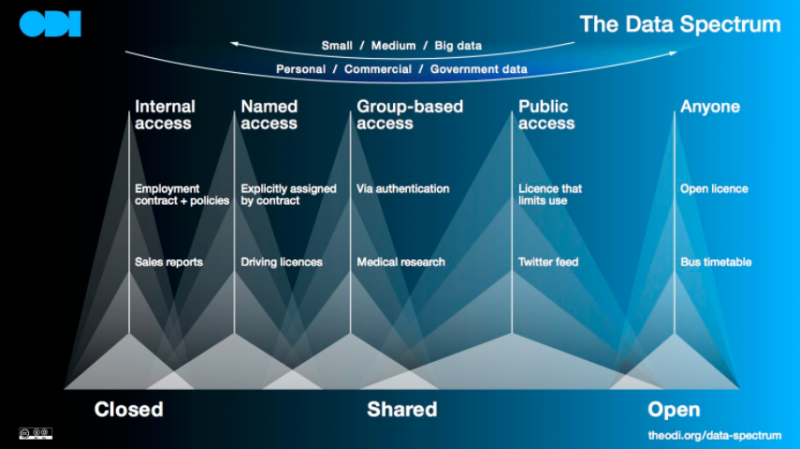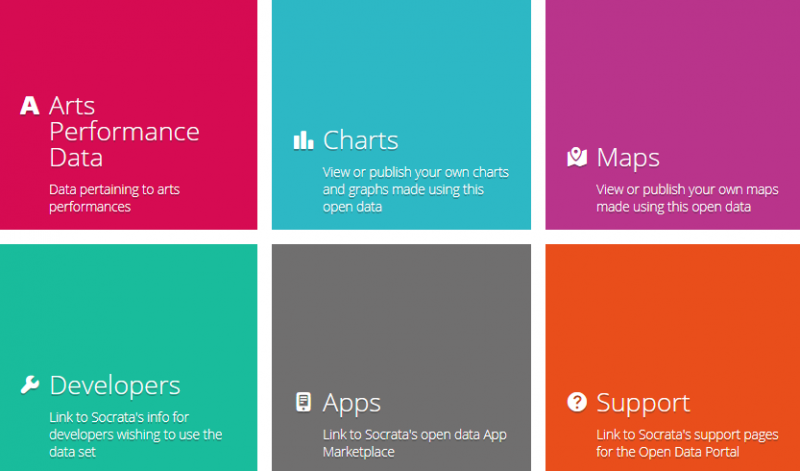
Open to opportunities
Sharing information openly supports innovation and helps build resilience for the good of the whole sector, argues Cimeon Ellerton.
Open open open open open open – has that word lost all meaning yet? Data data data data data data – are you spotting the pattern? Before I share the full gory details of The Audience Agency’s approach to open data in the arts, I thought I’d try to undermine what we think we already know about those two words with a little ‘semantic satiation’ (repetition of a phrase to the point where it temporarily loses its meaning).
What then might be a more helpful way to think about open data? Our friends at the Open Data Institute (ODI) have created the Data Spectrum infographic below to help clarify the concept, demonstrating how data does not exist in just one state or another (open or closed) but on a spectrum between the two. The position on this data spectrum relates the level of openness to the level of access offered. In other words, open data is about shared data.

The latent value of data
In the open data sphere, the extent to which data is shared freely (with anyone, or not) and the purpose for which the data may be used (for anything, or not) is formalised in a licence that sets out who can use something and how.
Imagine a world where you could even earn money from your data and make everything simpler and more connected
We work hard through services like Audience Finder to collect, clean, standardise, aggregate, link, anonymise and code data, and in doing so – a bit like a copyright – we gain a database right.
“But that’s my data!” I hear you say. Yes, that’s broadly true, but sometimes the latent value in the data is hard to extract for the following reasons:
- It needs to have the noise removed (such as incomplete or incorrect entries).
- It often benefits from having other data appended or linked to gain context and meaning, such as our Audience Spectrum types.
- Most importantly, it needs to be structured in the right way.
These are the engines generating power from data, without which the power is only potential.
Think about your own data, especially personal information, and how you share it or choose not to. Where does it exist on this spectrum? When you think carefully about the answer, you might be surprised. All those pesky agreements that we tend to click through absent-mindedly when registering for digital services often force us further along the scale from closed to open.
Does this spectrum help you consider more carefully what the value exchange is on all those free services we sign up to? Our images, words and even location are mined for power by those service-providers, so that they can extract the value latent within the data.
Opening up the data
The exciting thing about GDPR is that its aim is not to make life difficult for those of us who want to use the power of data, and nor is it intended to make the data more locked down and closed. It is actually to put the power in our hands (the data subjects) and, equally importantly, to encourage the portability of data for individuals and households to whom aspects of most big digital datasets tend to relate. Imagine a world where you could even earn money from your data and make everything simpler and more connected through who you choose to open your personal data store to.
The Audience Agency helps people working in the cultural sector to share and gain power from data on this spectrum in controlled ways, from named access in Show Stats for touring companies, to group access in Audience Finder dashboards, through to fully open de-identified datasets at our own Open Data portal.
But what’s the point of this level of open data? If basic shared data meets most needs through, say, Audience Finder, why have we made a subset of that data available through the Open Data portal?
First, we feel ethically motivated to make the data open. As a charity, our charter sets out how we will seek to create the maximum value for our community. And second, as much as we would love to spend even more time exploring the data than we already do to see what stories we might find there, our focus has to be on doing the everyday things, providing the well-established services and analyses that help the sector apply an evidence-based approach to developing relevance, reach and resilience.
Explore the data for yourself
If your inner nerd’s interest is piqued, head over to the Audience Finder aggregate data on our Open Data portal.
This allows anybody to play with that data, to cut it and slice it, to analyse and visualise it either through a suite of online tools, or by downloading the dataset and applying your own software tools. So the next time you want to know XYZ about audiences in England and Wales, try the Open Data portal, on top of Audience Finder and Show Stats. Go have a play – you can’t break it.
New insights
An important part of resilience is having the time, space and processes to think and behave differently, to not always do things in the same way – because the world changes and audiences do too. So, to help us as a sector innovate and stay resilient, we make this data open so that anyone (academics, funders, policy-makers, start-ups and anyone else interested in creating value for the sector) can investigate, in the hope that many minds may make light work.
Someone else might be able to bring their own resources, skills and interests to the challenge of extracting the latent value from the data, leading to new insights that could ultimately change what we do or how we do it for the better. At a time of increasing audience mobility and greater competition for audience attention, the need to understand audiences in a deeper and richer way is vital for funding agencies, policy-makers, arts organisations and, increasingly, for scholars.
To this end, we have put out a call to stimulate new critical debate on the potential of emerging audience research methods. We have invited academics across the world to contribute to a special issue of Cultural Trends. Through our open data, a range of academics will analyse the contribution that the Audience Finder dataset makes now (and might make in the future) to our knowledge of audiences, the audience development strategies of cultural organisations and the policy development of public funders and regulatory bodies.
Sharing standards
Doors are being opened beyond just data itself. Open standards are becoming increasingly common, driven by both policy and business, ranging from the UK Government’s Open Standards Principles to the Open Banking Standards. These standards make for easy interoperability between software, data and document formats. In other words, they do the following:
- They avoid vendor lock-in to a specific piece of technology or supplier. The next time you want to change your CRM, ticketing or website supplier, the process will be cheaper, faster and doesn’t lose important historic data.
- They ensure software interoperability, meaning that all your different systems talk to each other without costly custom integrations.
- They show which suppliers are committed to creating value together and which see cooperation as competition.
- They will ultimately reduce the overall cost of digital services and platforms.
With this in mind, we are pursuing a number of projects that will start to develop an ‘open audience standard’ in the arts and cultural sector, supported by a policy commitment in the Culture is Digital white paper from the DCMS: “The Space and The Audience Agency will work with arts and cultural organisations, Nesta, the BBC and other content publishers and partners to develop a metrics framework and best practice guidance for arts and cultural organisations to use when planning and assessing audience engagement across different digital platforms.”
We’re also hoping to host some hack days with the BBC to ask new questions of two datasets that have never been combined before about the cultural, entertainment, digital, arts and heritage interests and behaviours of UK residents. Here’s to throwing the data doors wide open in 2019 – there is much to look forward to.
Cimeon Ellerton is Chief Operating Officer at The Audience Agency.
www.theaudienceagency.org
This article, sponsored and contributed by The Audience Agency, is in a series sharing insights into the audiences for arts and culture.

Join the Discussion
You must be logged in to post a comment.